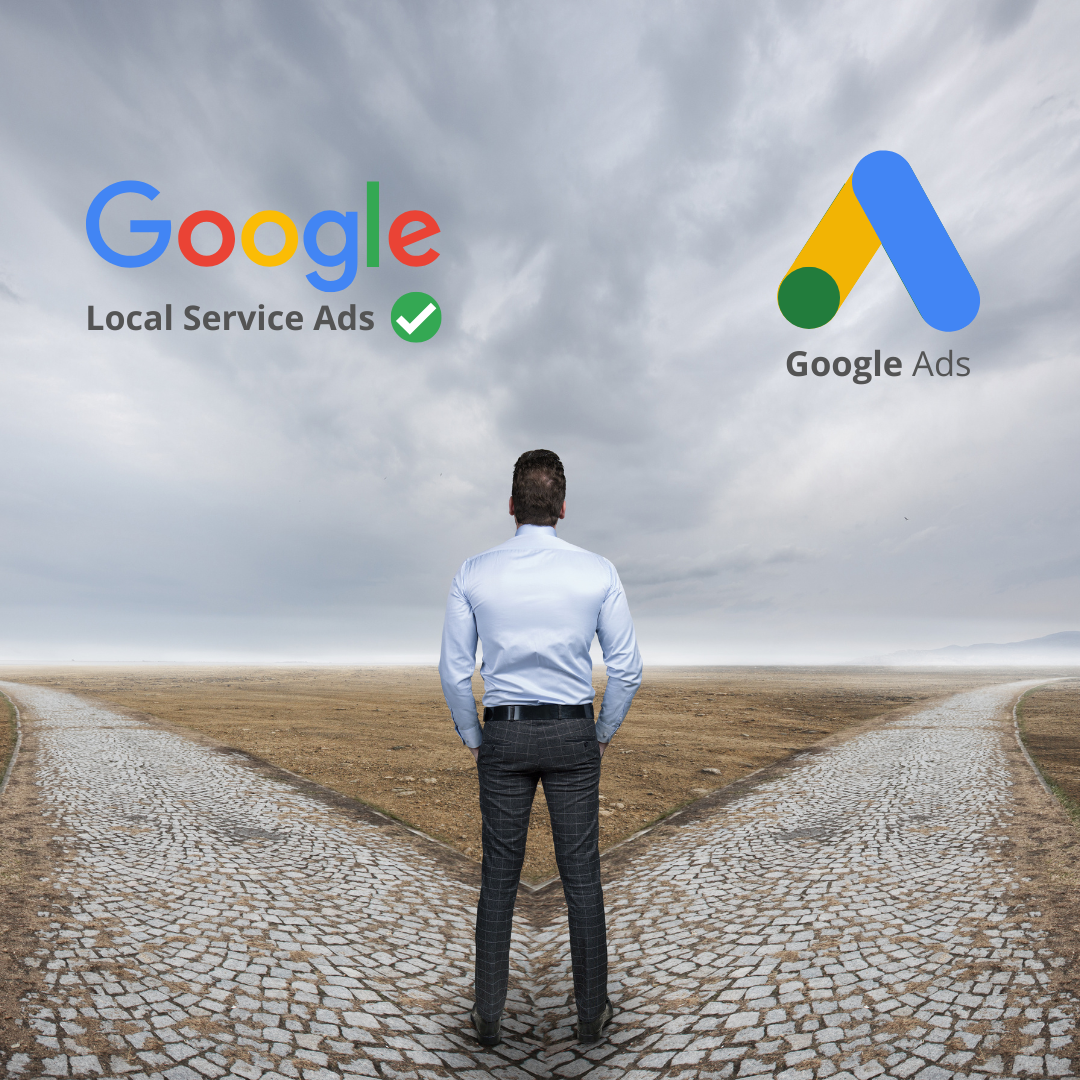Google LSAs vs. Google Ads: Which Is Better for Your Home Service Business?

Should you invest in Google Local Services Ads (LSAs), Google Ads, or both to grow your home service business? It’s a decision many business owners in the industry face. With online advertising now essential for visibility and lead generation, choosing the right option can mean the difference between consistent client bookings and poor results.
This blog breaks down how Google LSAs and Google Ads work, their pros and cons, and how to decide which is best for your business goals. Whether you’re an HVAC company, pest control service, or cleaning business, we’ve got actionable insights to help you maximize your ROI.
What Are Google LSAs and Google Ads?
Google Local Services Ads (LSAs)
Google Local Services Ads (LSAs) are designed to help local businesses connect with nearby customers, making them a powerful tool for boosting visibility and generating leads. For example, when someone searches “plumber near me,” LSAs appear at the very top of Google search results, even above regular Google Ads, putting your business in the spotlight.
What makes LSAs stand out is the Google Guaranteed badge, which shows customers that your business has been vetted by Google for quality. For service providers, this builds trust and reassures customers about your professionalism.
You can customize your ads with details like service types, hours, and locations to better target your audience. By using LSAs, local businesses can build credibility, improve visibility, and attract more quality leads, making them essential in today’s competitive market.
Key Features of LSAs
Pay-per-Lead Model: You pay only for qualified leads, such as a call or message from a potential customer.
Simplified Setup: LSAs are designed for ease of use, focusing on service areas and not requiring advanced targeting settings.
Local Focus: Your ads will be shown to potential customers in your immediate vicinity.
Highest Placement in Search Results: Always ranking above Google Ads, LSAs ensure maximum visibility.
Google Ads
Google Ads, formerly AdWords, is Google’s pay-per-click (PPC) advertising platform that lets businesses create customized ad campaigns. It offers extensive targeting options to reach specific audiences based on keywords, location, device, demographics, and behavior.
Unlike Local Services Ads (LSAs), designed for service businesses in specific areas, Google Ads offers broader reach, making it ideal for businesses of all sizes. Advertisers can choose from various formats, including search, display, video, and shopping ads.
It also includes robust analytics tools to track performance, measure ROI, and make data-driven improvements. With its flexibility and scale, Google Ads is a powerful tool for driving traffic, generating leads, and boosting brand visibility.
Key Features of Google Ads
Pay-per-Click Model: You’re charged when someone clicks on your ad, which typically leads to your website or a landing page.
Advanced Targeting Options: Ads can be fine-tuned based on demographics, location, and even user devices.
Customization: Take full control of your ad copy, budgets, and landing pages.
Scalability: Perfect for local campaigns or expanding into regional/national markets.
Would you rather reach homeowners in your city or cover an entire state? With Google Ads, the choice is up to you.
Pros and Cons of Google LSAs
Advantages of LSAs
Trust Factor: The "Google Guaranteed" badge boosts customer confidence. Awarded to businesses that pass Google's strict vetting, including background checks and license verification, it shows your business is trustworthy, encouraging customers to choose you over competitors.
Cost Control: Unlike traditional pay-per-click (PPC) ads, LSAs charge per lead, meaning you only pay for qualified inquiries that match your services. This ensures a better return on investment (ROI) by focusing on real leads instead of irrelevant clicks. It’s an efficient model for businesses managing tight budgets.
Ease of Use: Managing LSAs is much simpler than platforms like Google Ads or Facebook Ads. LSAs don’t require knowledge of keywords or bidding strategies. Set your budget, define your service areas, and Google handles the rest. For busy business owners, LSAs save time and effort.
Limitations of LSAs
Limited Control: Businesses have little control over ad content, layout, or messaging. Google generates your ad using the information you provide, such as business details and reviews. While this simplifies setup, it limits your ability to stand out with unique branding or messaging.
Restricted Availability: LSAs are only available for certain industries, like plumbers, electricians, cleaners, and legal professionals, and aren’t supported everywhere. If your business operates outside these categories or in unsupported areas, you won’t be able to use LSAs.
High Competition: As LSAs grow in popularity, more businesses compete for top spots, especially in crowded markets. This competition can increase cost per lead, making it harder for smaller businesses to compete with larger ones. Monitoring ad spend and ensuring leads convert into paying customers is essential.
"Google LSAs are perfect for businesses that want quick, local leads without having to tinker too much with ad settings or strategy. It’s a set-it-and-go solution.” – Avram Gonzales, Chief Strategist at Digital Harvest
Pros and Cons of Google Ads
Advantages of Google Ads
Customization: Google Ads gives you full control over your campaigns. You can tailor ad copies, visuals, targeting, and landing pages to match your goals. Target specific demographics, keywords, locations, or even the time your ads appear to reach the right audience at the right moment.
Versatility: Whether you're a local business or a global company, Google Ads suits campaigns of all scales. Create local campaigns to target customers near your store or run international campaigns for a global audience. The platform supports search, display, video, and shopping ads, adapting to various marketing needs.
Scalability: Google Ads is perfect for businesses looking to grow. Start with a small budget and scale as you see results. Experiment with new markets or products with minimal upfront investment, making it easier to expand and grow your customer base.
Limitations of Google Ads
Learning Curve: The platform is feature-rich but can be overwhelming for beginners. Setting up campaigns, choosing keywords, writing ad copy, and tracking performance require a good understanding of digital marketing. Without expertise, businesses risk wasting time and resources.
Risk of Overspending: Since you pay per click, poor budget management can lead to high costs. Overspending often happens when targeting competitive keywords without a clear strategy or failing to track conversions to measure ROI.
High CPC (Cost Per Click): In competitive industries, CPCs can be very high, making it harder for businesses with limited budgets to compete. Industries like legal services or insurance often have CPCs between $20 and $100 or more, requiring careful evaluation of potential returns.
Google LSA vs. Google Ads: Side-by-Side Comparison
When deciding between Google Local Services Ads (LSAs) and Google Ads, it's important to understand their distinct approaches and how they cater to different goals. Here’s a deeper look at the key differences and use cases to help you make an informed decision.
Key Differences
Aspect | Google LSAs | Google Ads |
Cost Model | Pay-per-lead | Pay-per-click |
Placement in Search Results | Ranks above Google Ads in most cases | Appears below LSAs in search results |
Control | Limited customization; Google decides rankings based on factors like proximity, reviews, and background checks | Full control over targeting, keywords, bids, and creative content |
LSAs are designed to simplify advertising for service-based businesses by focusing on direct leads, while Google Ads allow for greater flexibility in creating tailored campaigns and reaching a broader audience.
Use Case Examples
LSAs: Imagine a small roofing company that serves one specific city and specializes in emergency repairs. LSAs are perfect here—they generate high-quality leads from local customers searching for urgent assistance.
Google Ads: On the other hand, a pest control business that offers services across multiple states might benefit more from Google Ads. With this platform, they can run seasonal campaigns targeting specific regions, bidding on relevant keywords to expand their reach.
How to Choose Between Google LSAs and Google Ads
Choosing between Google LSAs and Google Ads can be tricky, but aligning the platform with your goals simplifies the process. Each offers distinct advantages, so knowing your priorities is key.

Consider Your Business Goals
When deciding which platform is right for you, think about what you’re aiming to achieve.
Focus on LSAs for:
- Quick local leads, especially for service-based businesses.
- Budget-conscious campaigns with minimal setup, making them ideal for small, local operations.
Focus on Google Ads for:
Larger campaigns with detailed targeting needs, such as demographics, interests, and search behavior.
Expanding into new markets or reaching a broader audience outside your immediate area.
Why Not Use Both?
Who says you have to pick one? Combining LSAs and Google Ads allows you to maximize visibility and capture leads from various angles.
For example, a cleaning service can rely on LSAs to attract customers in their local neighborhoods while running Google Ads to target broader suburbs or niche cleaning services.
By leveraging the best of both worlds, your business can achieve comprehensive coverage and generate more qualified leads tailored to your goals.
Finding the Right Fit for Your Business
Taking your home service business to the next level means reaching the right customers at the right time. Google LSAs are perfect for those seeking local leads with minimal complexity, while Google Ads thrive with businesses in need of scalability and customization.
Evaluate your goals, budget, and resources to decide whether LSAs, Google Ads, or a combination of both will provide the most value.
Need guidance on setting up the perfect strategy? Reach out to us at Digital Harvest or connect with Avram Gonzales on LinkedIn. Let's map out the best advertising plan for your home service business!
